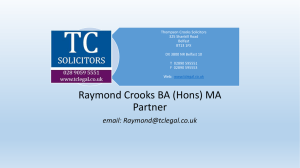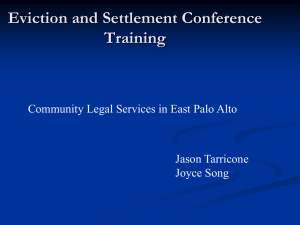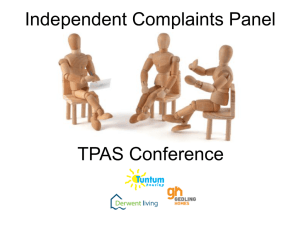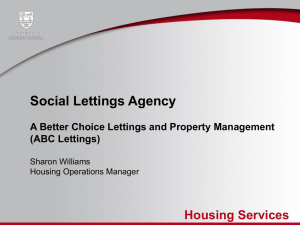5 DAYS - Infopeople
advertisement
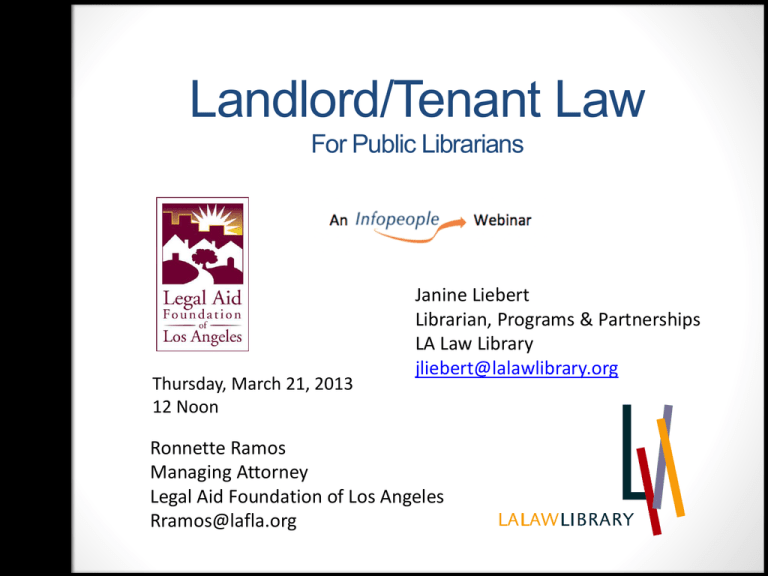
Landlord/Tenant Law For Public Librarians Thursday, March 21, 2013 12 Noon Janine Liebert Librarian, Programs & Partnerships LA Law Library jliebert@lalawlibrary.org Ronnette Ramos Managing Attorney Legal Aid Foundation of Los Angeles Rramos@lafla.org Agenda • Provide a general overview of landlord - tenant law matters and the eviction process • Become familiar with key terminology in landlord tenant law matters • Tour the California Court’s self-help center’s sections on evictions and housing • Learn about additional print and online resources addressing landlord – tenant issues Landlord-Tenant Overview • Rights and responsibilities of CA tenants and landlords • What is a UD? • CA Laws • Eviction Process • Timeline • Types of Notices • Pleadings and Responses • Most Commonly used UD Defenses • Foreclosure • Security Deposits Tenant’s Legal Rights and Responsibilities • Pay Rent • Take reasonable care of the rental unit • Repairs • Limits on the Landlord’s right of entry • Security deposit limits • Time to return security deposit • Itemized accounting Tenant’s Legal Rights and Responsibilities • Repair and deduct • Withhold rents • Sue for damages • Right to warranty of habitability • Protection against retaliatory eviction Refund of Security • Allowable deductions: Deposits • Unpaid rent • Cleaning the rental unit when tenant moves out • Repair of damages other than normal wear and tear • If the lease allows for cost of restoring or replacing personal property (such as keys or furniture) • 21 calendar days or less after tenant moves out • Send tenant a full refund of security deposit OR • Mail or personally deliver an itemized Landlord’s Responsibilities • Implied covenant of quiet enjoyment • Landlord must make the unit fit to live in, or habitable • Landlord must repair problems that make the rental unit unfit to live in or uninhabitable What is an Unlawful Detainer? • Statutory procedure defined under California Code of Civil Procedure §1161-1179a • Lawsuit that a landlord must file and win before he or she can evict a tenant • Also called an eviction lawsuit Rent Control • Protections: • Rent increases are limited on a yearly basis • Greater Tenant Protections • Cities with Rent Control Berkeley Beverly Hills Glendale Hayward Los Angeles Oakland Richmond Ridgecrest San Francisco Santa Monica West Hollywood East Palo Alto Maywood Palm Springs San Diego Thousand Oaks Who are the Parties Involved in an Unlawful Detainer? Plaintiffs in Unlawful Detainers Management Companies Corporation Plaintiff NonProfits Tenants Landlord Defendants in Unlawful Detainers Foreclosed Landlords Managers/ Employees Defendant Subtenants Hotel Lodgers Tenants THE UNLAWFUL DETAINER (EVICTION) PROCESS 3/30/60/90/120-DAY NOTICE SUMMONS AND COMPLAINT 5 days ANSWER About 1 week TRIAL NOTICE About 1-2 weeks COURT SETTLE TRIAL DISMISSAL I HAVE NO GOOD LEGAL DEFENSES I WANT TO MOVE I HAVE NO $$ TO PAY BACKRENT I HAVE GOOD LEGAL DEFENSES I WANT TO STAY IN MY HOME I HAVE THE $$ TO PAY BACKRENT TENANT STAYS & PAYS RENT HABITABILITY DEFENSE TECHNICAL DEFENSE WIN PAY RENT LOSE LOSE In 5 to 14 days you will receive a 5-DAY NOTICE TO VACATE SHERIFF LOCK-OUT WIN PAY REDUCED BACK RENT Notices to Terminate a Tenancy No Cause / Fault Notices • 30/60/90-day notice to vacate • Non-rent control properties • 90-day notice • Government subsidized housing For Cause Evictions • Three-day notice to pay rent or quit • Three day notice to cure or quit • Three-day notice to quit Three-Day Notice to Pay Rent or Quit • For when tenant is behind on the rent • Three days begins on the first day after service of the notice • If the third day falls on a Saturday, Sunday or legal holiday – the three-day period will not expire until the following Monday or nonholiday Three-Day Notice to Cure or Quit • For when tenant is violating terms of the lease or rental agreement, other than nonpayment of rent, and the problem can be fixed • Must specify violation • Written lease agreement must exist Three-Day Notice to Quit • For when tenant is violating terms of the lease or rental agreement, other than nonpayment of rent, and the problem cannot be fixed: • committing “waste” • creating a nuisance on the premises • Illegal use Tenant Defenses for Defective Notice Pay or Quit Notice: • Rent is not due • Includes late fees • Demands more rent than tenant owes • Fails to state specific information pursuant to C.C.P. §1161(2) • Fails to state amount due Perform or Quit Notice: • Fails to state how to cure alleged violation • No written lease • Not in the alternative and breach is “curable” Applies to all: • Does not declare a forfeiture of the lease • Defective service of notice Service of Notice • Notice may be served upon the Tenant in one of three ways: • Personally • Leaving a copy with a person of suitable age and sending a copy by mail • Nail and mail Step 2: The Unlawful Detainer The court eviction process begins by filing a summons and complaint Named Defendant(s) must be served a copy of the summons and complaint The Court will mail out a Notice stating that UD lawsuit has been filed Common Defective Complaint Defenses • Notice not attached • Lease not attached: • Cases not based on failure to pay rent. • Tenant named but incorrect address • Improper Plaintiff: • Plaintiff must have some right of possession to the property either as the owner or agent of the owner How to Respond to an Unlawful Detainer Complaint Responsive Pleadings • Answer • General denial or deny each allegation in the complaint • Technical and factual defenses • If in doubt, raise the defense, otherwise it is waived • Pre-Judgment Claim of Right to Possession • If tenant is in possession and not named on complaint • Demurrer • Plaintiff failed to state a cause of action • Complaint is unclear Step 3: Filing a Response 5 DAYS to file an answer Fail to file an answer, a default judgment will be entered and tenant will have to vacate Answering defendant must claim defense(s) to complaint’s allegations Timeline for Trial Continue Discovery Request to Set Case for Trial Service of Complaint 5 days File Responsive Pleadings 1 or 2 weeks Start Discovery 1 week Date of Trial 2 weeks Notice of Trial (file jury demand & post fees) Pre-Trial Considerations • Jury Trial Demand: • Must be filed within 5 days of the Notice of Trial date (C.C.P. § 631(d)(4)) • Jury Fees: $150 at least 5 days before trial • Motion for Summary Judgment (C.C.P. § 437c): • No triable issue of material fact • Defendant must show Plaintiff does not have a cause of action • Filed upon 5 days notice (C.C.P. § 1170.7) and opposition may be filed 1 day before or on hearing day. • Trial Date: • Request to Set Case for Trial • Discovery: Discovery and Unlawful Detainers Civil Discovery Act C.C.P. § 2016 et seq. Types of Discovery: Time Limitations: • Written Interrogatories • Form (UD-106) • Special Interrogatories • Discovery completed 5 days before the date of Trial • Demand for Production of Documents • Request for Admissions • Depositions • Scheduled w/in 5 days of the Notice but no later than 5 days before Trial • Responses due w/in 5 days for personal service, 10 days for mailing • Motions to Compel may be filed at any time upon 5 days notice Commonly Used Tenant Defenses • Waiver of Notice to Quit • Generally: Affirmative defense if landlord accepts rent to cover a period of time after the termination date stated in the notice • Estoppel • Generally: Tenant must have relied on the landlord’s conduct and was injured by it • Breach of the Warranty of Habitability • What is a breach? • Proof of a substantial breach • Retaliatory Eviction • Discrimination After the Court’s Ruling • If tenant wins • Tenant will not have to move and pay back rent • Landlord may be ordered to pay court costs • If landlord wins • Court issues Writ of Possession • Service of Writ and posting of 5 day Notice to Vacate • Sheriff will remove all occupants Default Judgment if Tenant Fails to File Answer within Five Days • Default judgment entered in favor of landlord • Writ of possession • Service of writ and posting of five day Notice to Vacate • To request additional time, tenant must file Stay of Execution with the court • Sheriff will remove all occupants • Setting aside default judgment requires proof of mistake, inadvertence, excusable neglect Abandoned Personal Property Left in a Rental Unit • California law has specific steps to follow to get possessions returned • Civil code § 1951.3 • Identify and value the property left behind • Send possible owners notice • If tenant does not respond to Notice • Property worth less than $750 = Landlord • Property worth more than $750 = auction • Notice of Right to Reclaim Personal Property Protecting Tenants at Foreclosure Act • Applies to all residential properties foreclosed after 5/20/2009 • Does not preempt local and state laws that offer additional protections • 90-Day Notice required unless lease term not yet expired • Must be “bona fide” tenant. • Section 8 Tenants: new owner subject to lease and contract with PHA Online Resources for Locating Information, Forms and Referrals California Courts – Online Self-Help Center http://www.courts.ca.gov/ California Courts – Online SelfHelp Center http://www.courts.ca.gov/selfhelp.htm • For each case type, provides basic information about applicable law • Outlines steps in court process • Forms presented within informational context • Instructions for completing each form “Getting Started” California Courts Online SelfHelp Center http://www.courts.ca.gov/1002.htm “Eviction and Housing” California Courts Online SelfHelp Center http://www.courts.ca.gov/selfhelp-housing.htm Foreclosures - http://www.courts.ca.gov/1048.htm Security Deposits – Demand Letter http://www.courts.ca.gov/1230.htm Landlord-Tenant Legal Guides Dept. of Consumer Affairs Website http://www.dca.ca.gov/publications/legal_guides/index.shtml California Tenants – A Guide to Residential Tenants’ and Landlords’ Rights and Responsibilities How to Get Possessions Back You Have Left in a Rental Unit Options for a Landlord: When a Tenant’s Personal Property Has Been Left in the Rental Unit Landlords and Tenants Responsibilities For Habitability and Repairs Rent Increases: Basic Information for Tenants Online Resources – California State Bar http://www.calbar.ca.gov/Public/LegalInformation/AboutFamily.asp x Law HelpCA.org www.lawhelpca.org LawHelpCA.org – Housing www.lawhelpca.org Locating Self-Help Centers in California California Courts’ Self-Help Centers and Family Law Facilitators Reference Guide http://courts.ca.gov/documents/Publ ic_Locations_Directory_4-9-12.pdf Downloadable brochure provides locations for family law facilitators and self-help centers located in every county in California JL Locating Law Libraries in CA Council of California County Law Librarians http://www.publiclawlibrary.org JL Nolo Books – Legal Information Reference Center (EBSCO Host) California consortium hosts full access (remotely) by county • Example: LA Law Library http://www.lalawlibrary.org/research/onsite/default.aspx Login: CA / LA Nolo Books – Legal Information Reference Center (EBSCO Host) Thank You! Janine Liebert Librarian, Programs & Partnerships LA Law Library jliebert@lalawlibrary.org Ronnette Ramos Managing Attorney Legal Aid Foundation of Los Angeles Rramos@lafla.org Infopeople webinars are supported by the U.S. Institute of Museum and Library Services under the provisions of the Library Services and Technology Act, administered in California by the State Librarian. This material is licensed under a Creative Commons 3.0 Share & Share-Alike license. Use of this material should credit the author and funding source.
